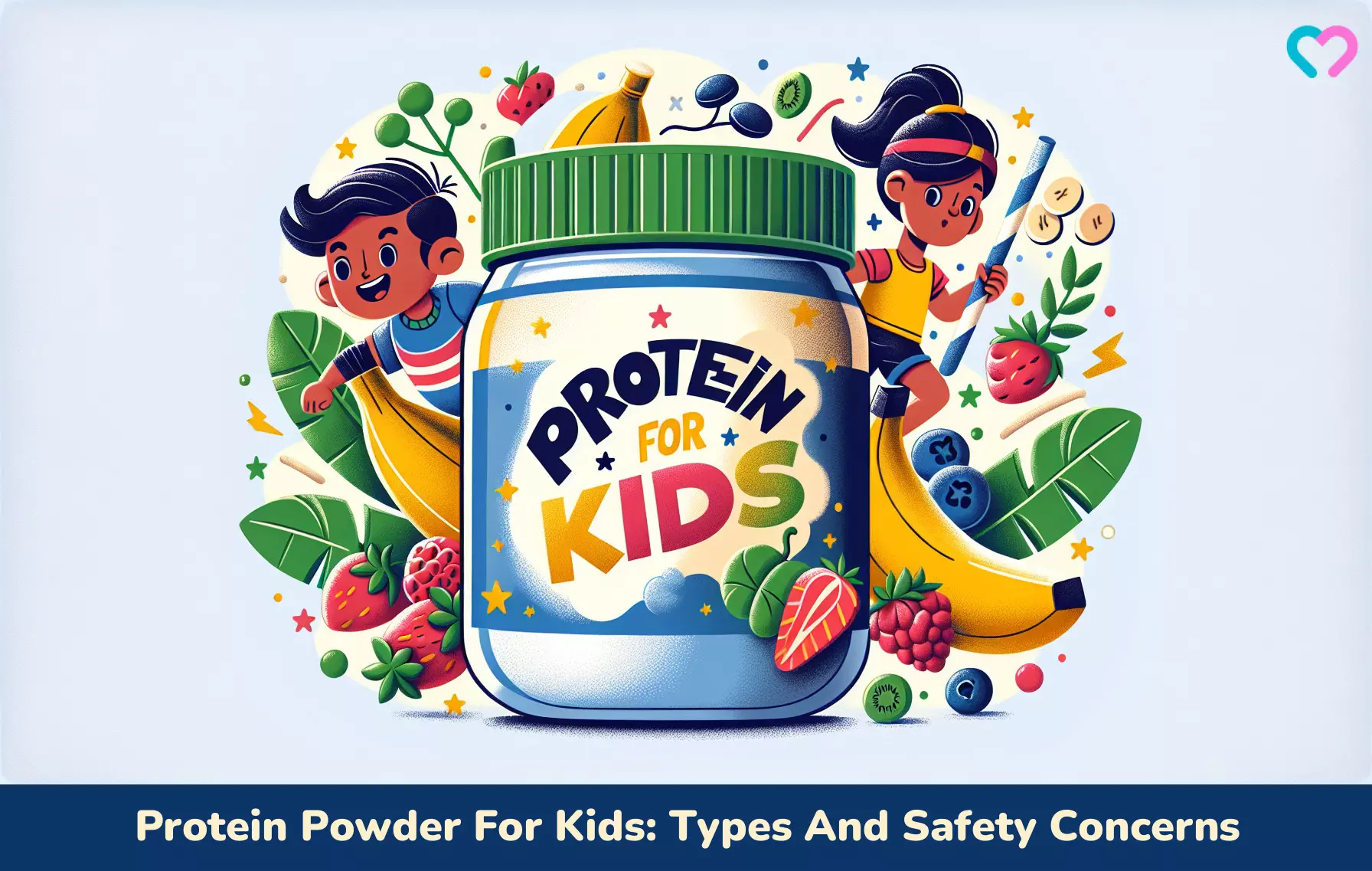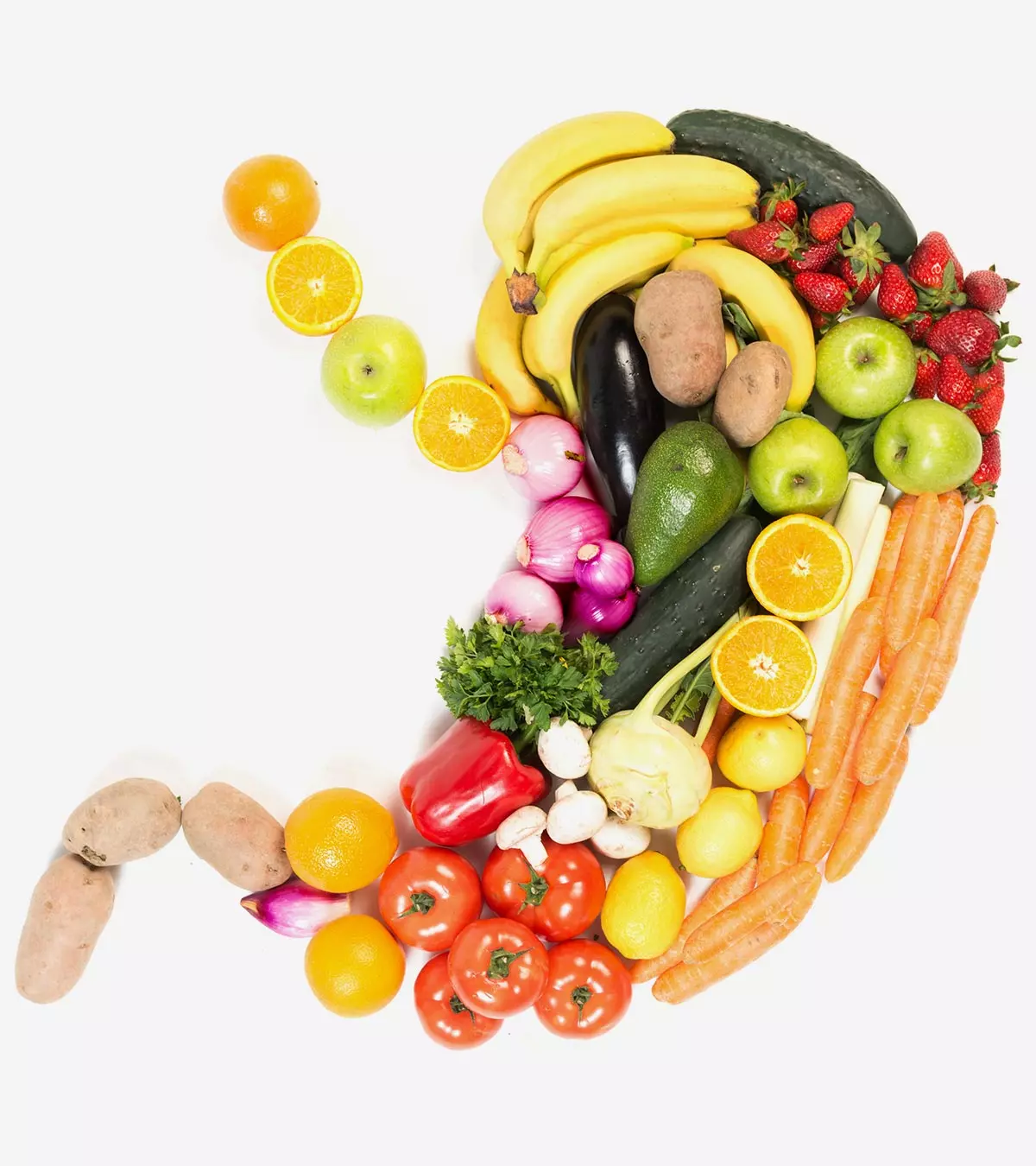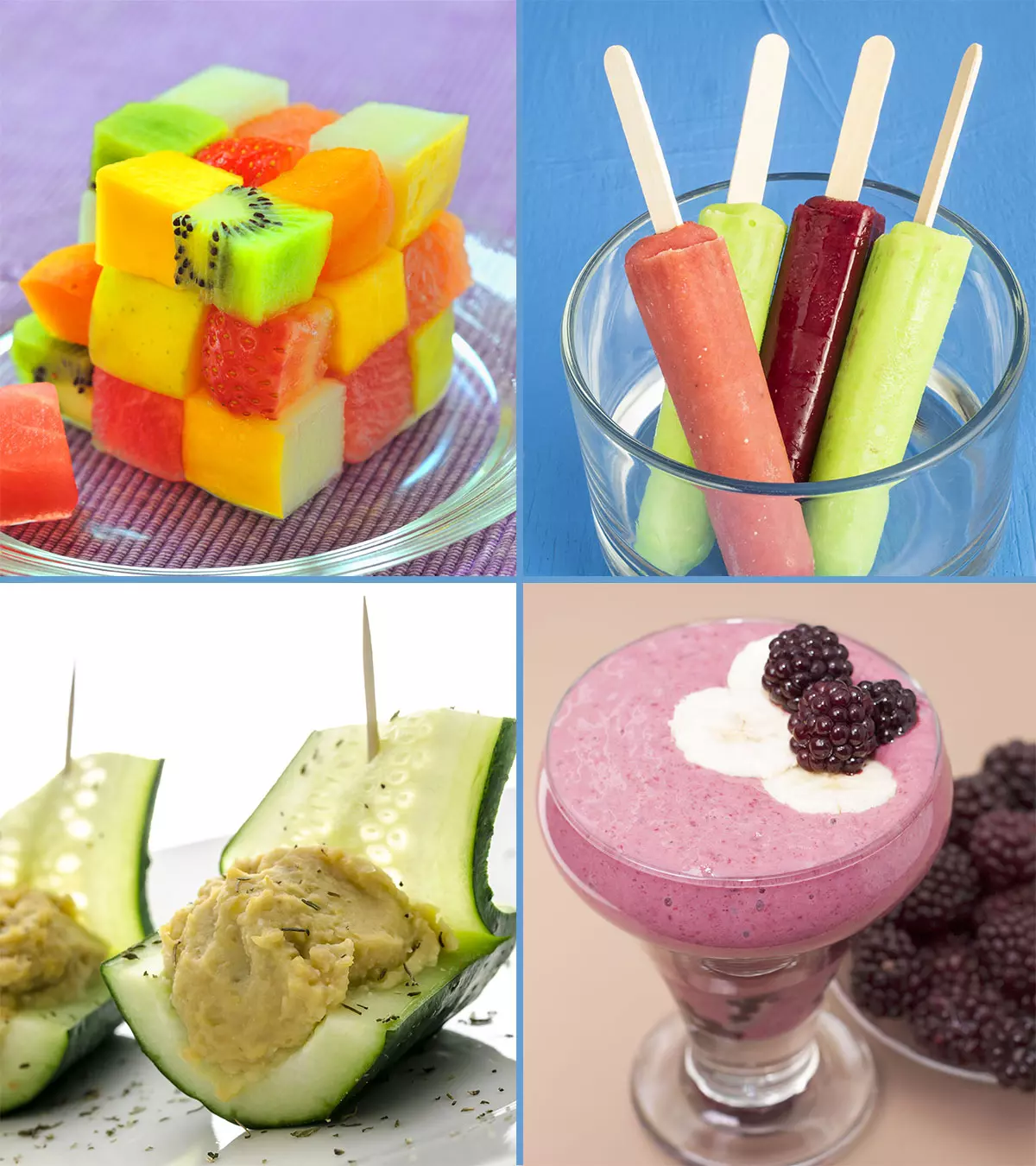
Image: Shutterstock
Protein powders are used for muscle development and weight gain by adults. However, doctors may recommend protein powders for kids only to fill nutritional gaps. These powders are derived from plant and animal sources. Apart from amino acids, these also contain other substances such as artificial sweeteners, artificial flavors, multi-vitamins, minerals, preservatives, and thickeners (1). Hence, they must be administered to children after a doctor’s prescription. Mostly, children who consume a balanced diet do not need additional high-protein supplements but if your doctor recommends, then know more about protein powders, their types, and safety concerns for children from our post.

Key Pointers
- The long-term effects of protein powders on kids are still unknown as they are dietary supplements.
- Before giving protein powders to your child, consult with a doctor.
- Children require additional protein intake if they are participating in sports, struggling to gain weight, or have metabolic issues.
- Overconsumption of protein can lead to gastrointestinal problems, kidney stones, loss of nutrients, and excessive weight gain.
- Natural sources of protein include legumes, soy foods, vegetables, grains, seeds, nuts, turkey, chicken, and eggs.
Is Protein Powder Safe For Children?
Protein powders are dietary supplements that do not undergo the US Food and Drug Administration’s (US FDA) testing, regulation, and approval process, unlike prescription drugs (2).
The quality and safety of these supplements are left up to the manufacturers to evaluate.
According to the American Academy of Pediatrics (AAP), supplements can be susceptible to contamination, safety problems, and quality issues, even when purchased from a reliable source (1). Also, the safety and long-term effects of protein supplements is still under research and not completely known. Therefore, if you wish your child to have protein powder, then seek a pediatrician’s advice.
Meanwhile, you may want to add the following dietary sources of high-quality protein:
With growing understanding of food and nutrition in overall health our approach is shifting towards complete nutrition rather than focusing on a single factor. So the terms like high-quality protein or complete protein have come into existence.
A high quality or complete protein is the one which contains all essential amino acids (amino acids which cannot be produced in the body and so have to come from diet). Amino acids are the building blocks of protein in our body. Examples of high quality protein are:

- Beans
- Nuts and seeds
- Tofu and soy products
- Fish
- Poultry
- Dairy products
Adding a variety of protein-rich foods in your child’s daily diet can help maintain optimum intake. Most animal-based foods are a rich source of complete protein with all essential amino acids (1). Some of the good animal sources of protein are turkey, chicken, fish, eggs, milk, cheese, and lean beef (2).
How Much Protein Do Children Need?
According to the Dietary Guidelines For Americans (2015-2025), children’s protein requirement depends on their age, sex, and activity.
The following are the optimum recommended dietary allowance values for children and teens of various age groups (4).
| Age (years) | RDA (g/day) |
|---|---|
| 1 to 3 | 13 |
| 4 to 8 | 19 |
| 9 to 13 | 34 |
| 14 to 18 (girls) | 46 |
| 14 to 18 (boys) | 52 |
Source: Dietary Guidelines For Americans 2015-2025
There are several vital plant-based protein sources for children on a vegetarian or vegan diet. Below is a list of plant foods with approximate protein quantities per serving (3).
| Protein-rich Plant Foods | |||
|---|---|---|---|
| Food | Serving | Calories | Protein (g) |
| Legumes (cooked) | |||
| Lentils | ½ cup | 101 | 9 |
| Black Beans | ½ cup | 114 | 8 |
| Pinto Beans | ½ cup | 123 | 8 |
| Red Kidney Beans | ½ cup | 112 | 8 |
| Black-eyed Peas | ½ cup | 100 | 7 |
| Chickpeas | ½ cup | 134 | 7 |
| Soy Foods | |||
| Tempeh | ½ cup | 160 | 16 |
| Veggie burger (average)* | 1- 70 gram | 124 | 11 |
| Tofu* | ½ cup | 94 | 10 |
| Soymilk* | 1 cup | 132 | 8 |
| Vegetables | |||
| Peas, cooked | ½ cup | 67 | 5 |
| Artichoke, cooked | 1 medium | 100 | 4 |
| Spinach, cooked | ½ cup | 41 | 3 |
| Grains | |||
| Kamut | ½ cup | 126 | 6 |
| Wheat Berries | ½ cup | 151 | 6 |
| Quinoa | ½ cup | 111 | 4 |
| Oatmeal | ½ cup | 79 | 3 |
| Seeds | |||
| Pumpkin Seeds | 1 ounce | 159 | 9 |
| Flax Seeds | 1 ounce | 140 | 6 |
| Sunflower Seeds | 1 ounce | 140 | 6 |
| Chia Seeds | 1 ounce | 138 | 5 |
| Nuts | |||
| Peanut Butter | 2 tablespoon | 188 | 7 |
| Almonds | 1 ounce | 163 | 6 |
| Pistachios | 1 ounce | 160 | 6 |
| Hazelnuts | 1 ounce | 181 | 4 |
| Walnuts | 1 ounce | 185 | 4 |
Source: Academy of Nutrition And Dietetics
When Is Extra Protein Needed For Children?
Most children and adolescents in the US consume 1.5 to three times their daily recommended intakes (DRIs) for protein (5), suggesting sufficient protein consumption to meet the nutrient need. However, the protein requirement could increase in certain situations.
- Increased physical activity: The AAP recommends consuming two ounces (approximately 60 grams) of protein foods for every 1000 calories burned (6). An increase in calorie needs due to increased physical activity, such as in the case of an athletic child, demands an increase in protein intake. Consuming appropriate calories can help sustain sufficient energy levels throughout the day.

- Poor weight gain: Approximately four percent of children and teens in the US are underweight (7). Pediatricians suggest including weight gain foods for kids to help protein intake. Supplemental protein intake may be considered when dietary protein intake fails to suffice the weight gain.
- Metabolic issues and chronic illnesses: Certain metabolic conditions causing protein catabolismiBreaking down of protein molecules into smaller components to produce energy. or protein wastage and chronic illnesses eg. tuberculosisiInfectious bacterial disease of the lungs that spreads via contaminated droplets released by coughing, sneezing, or speaking. , cystic fibrosisiA genetic disorder affecting the lungs, pancreas, and digestive system by blocking the airways and organ ducts with mucus. , discharge after prolonged hospital stay may require increased protein consumption to make up for the protein requirement. A pediatrician may recommend protein powders after evaluating the child’s condition and dietary habits.
Pediatricians generally recommend a well-balanced, high-protein diet to meet the increased protein needs.
The use of protein powder is advised after a thorough evaluation of the need and contemplation of alternatives.
What Are The Side Effects Of Protein Powder For Children?

The consumption of protein powder by a child/teen without pediatric guidance may lead to the following side effects (1) (8).
- Gastrointestinal disturbances: Protein powders may lead to digestion-related issues, such as bloating, gas, flatulenceiAlso called farting, it is the act of passing gas through the anus. , diarrhea, and stomachache, in sensitive individuals. Children who are lactose intolerant may experience these symptoms on the consumption of whey or casein protein-based protein powder.
- Loss of nutrition: Replacing protein-rich food with protein powders could cause the child to lose out on other nutrients present in protein-rich foods. In the long-term, it may increase the risk of nutritional deficiencies.
- Unwanted weight gain: Protein powders may have a high sugar content that provides surplus calories. If the child does not have requisite calorie burnout to balance the intake, then there is a risk of weight gain. Some protein powders contain the compound creatineiAmino acid that helps in the functioning of the muscles, produced in the liver and kidneys, and also obtained from meat. , which may cause weight gain as a side effect.
- Kidney stones: Sustained excess consumption of protein powder may strain the kidneys due to the accumulation of by-products in the blood (9). In the long run, it might increase the risk of kidney stones (10).
Protein powders may also contain additives and other compounds that adversely affect a child’s health and fitness.
 Research finds
Research findsWhat Are The Different Types Of Protein Powders?
There are several types of plant and animal protein-based powders available over the counter. Some of the common ones are discussed here.
- Whey protein: Whey is a high-quality milk protein, which contains essential branched-chain amino acids (BCAAs). It has a high biological value (BV) of 104, making the protein easily digestible and optimally bioavailable for the body. It can support muscle protein synthesis, enhance strength and endurance, and stimulate growth (11) (12).
Overconsumption of whey protein powder may lead to side effects, such as diarrhea, bloating, nausea, reduced appetite, fatigue, and headache (13).

- Soy protein: The soy product is manufactured by isolating soy protein from soybeans. The quality of soy protein and its ability to support muscle protein synthesis is relatively lower than animal protein (14) (15). But soy protein can be safely consumed by most individuals, including those with dairy allergy and lactose intolerance.
Children and teens are recommended to consume soy products, such as tofu, tempeh, and miso, in their diet in moderate amounts. Overconsumption of soy protein may lead to gastrointestinal disturbances. Excess soy protein may increase the risk of Kawasaki diseaseiA condition causing inflammation of the blood vessels resulting in swollen hands and feet, rashes, and reddening of eyes. in young children with a genetic predisposition to the disease (16).
- Casein: It is a slow-digesting, high-quality milk protein with a similar effect on muscle protein synthesis as whey. The slow-digesting nature of casein leads to significant protein accretion in the long run.
Children and teens with dairy allergy or lactose intoleranceiA condition in which the body has trouble digesting lactose, the primary sugar found in dairy products. should consume whey or casein after doctor consultation. It is good to consult a doctor before serving soy protein, especially if the child has a family history of Kawasaki disease.
How To Choose Protein Powders For Kids?

Consult a pediatrician before picking a protein powder for your child/teen. You may use the following steps to select the best product.
- Buy organic, GMP-certified protein powder to ensure good manufacturing quality.
- Select a product suitable for your child/teen’s age. Several protein powders available over the counter are only for adults or specifically for athletes.
- Read the product label carefully and look for protein level information in the nutrition fact sheet to know the amount of protein per scoop.
- Check the ingredient list and select a product with one or fewer ingredients. Also, check if the product has one protein type or a mix, like whey and casein protein.
- Avoid products with additives, like sugar or artificial sweeteners, such as sucralose and maltodextrin.
 Quick tip
Quick tipFrequently Asked Questions
1. At what age can my child drink a protein shake?
Usually, children get enough protein every day if they eat two servings of lean protein (17). Children between the ages of nine and 13 need at least 34 grams of protein daily. The recommendation of protein for young athletes is around 1.0-1.4 grams per kilogram per day, meaning they need a bit more protein than their non-athlete friends (18). Protein shakes and smoothies can be added to the diet if protein intake falls below this limit. But ensure that the child gets the maximum protein from healthy whole foods.
2. How can I increase my protein intake without protein powder?
Include protein-rich foods like seafood, poultry, nuts and seeds, and dairy products. If vegetarian, include sources like tofu, lentils, soy milk, and nut butter in the daily meals. Choose quinoa over rice. Ancient grains like spelt and amaranth are good ways to boost protein intake without relying on supplements.
3. How can parents incorporate protein powder into their child’s diet?
When incorporating protein powder into a child’s diet, it’s important to do so in a safe and appropriate manner. Before introducing any new supplements or dietary changes to your child’s routine, it’s advisable to consult with a pediatrician or a registered dietitian. Start with small amounts first to ensure your child can digest it well. You can add protein powder to milkshakes, smoothies, or baked goods.
4. Can protein powder cause allergies in children?
Protein powders, like any other food product, have the potential to cause allergies in children (19). If a child has a known allergy to any of the ingredients in the protein powder, consuming it can trigger an allergic reaction. Suppose you’re considering giving protein powder to a child, especially if they have a history of allergies. In that case, it’s essential to consult with a healthcare professional, such as a pediatrician or allergist, to determine the suitability and safety of using protein powder in their specific case.
5. What are the signs of protein deficiency in children?
Protein deficiency in children can lead to several signs and symptoms. Insufficient protein intake can result in stunted growth and development in children. Protein is crucial for the growth and maintenance of muscles. Inadequate protein intake can lead to weak muscles, muscle wasting, reduced muscle strength, and anemia. Protein deficiency can also cause fluid accumulation in the tissues, resulting in edema (20).
There are certain conditions such as extensive physical activity or underlying health issues for which your pediatrician may recommend the added supplement of protein powder for kids. However, if your child is healthy and maintains a balanced diet with wholesome ingredients, they may not require additional protein powder. Remember to consult your child’s doctor about the side effects and requirements of protein powder before adding it to their diet, and it may be better to opt for natural protein-rich sources for children than supplements.
Infographic: Tips For Choosing Protein Powders For Children
Although children and teens get enough protein from dietary sources, factors including increased physical activity, poor weight gain, or chronic illnesses may require them to take protein powder. However, there are certain things you should be mindful of when choosing one. Check out the infographic below to learn some tips for choosing protein powders for children.
Some thing wrong with infographic shortcode. please verify shortcode syntaxIllustration: Protein Powder For Kids: Types And Safety Concerns

Image: Dalle E/MomJunction Design Team
Discover delectable and nourishing recipes designed for children and toddlers, utilizing a nut mix powder to facilitate healthy weight gain. Acquire the knowledge to craft over 10 delectable recipes incorporating protein powder.
References
- The hidden dangers of protein powders; Health Harvard Publishing
https://www.health.harvard.edu/staying-healthy/the-hidden-dangers-of-protein-powders - Nutrition and Supplement Use; Healthy Children; AAP
https://www.healthychildren.org/English/healthy-living/nutrition/Pages/Nutrition-and-Supplement-Use.aspx
- Protein in Vegetarian and Vegan Diets; Academy of Nutrition And Dietetics
https://higherlogicdownload.s3.amazonaws.com/THEACADEMY/859dd171-3982-43db-8535-56c4fdc42b51/UploadedImages/VN/Documents/Resources/Protein-Consumer.pdf - Appendix 7. Nutritional Goals for Age-Sex Groups Based on Dietary Reference Intakes and Dietary Guidelines Recommendations; Dietary Guidelines For Americans2015-2025
https://odphp.health.gov/our-work/food-nutrition/2015-2025-dietary-guidelines/guidelines/appendix-7/ - Nutrition Issues and Concerns; Bright Futures; AAP
https://www.aap.org/en/practice-management/bright-futures - Energy In: Recommended Food & Drink Amounts for Children; Healthy Children; AAP
https://www.healthychildren.org/English/healthy-living/nutrition/Pages/Energy-In-Recommended-Food-Drink-Amounts-for-Children.aspx - Prevalence of Underweight Among Children and Adolescents Aged 2–19 Years: United States, 1963–1965 Through 2017–2018 Centers for Disease Control and Prevention
https://www.cdc.gov/nchs/data/hestat/underweight-child-17-18/underweight-child.htm - Are protein shakes healthy?; Intermountain Healthcare
https://intermountainhealthcare.org/blogs/are-protein-shakes-healthy - Nutrition and Early Kidney Disease; National Kidney Foundation
https://www.kidney.org/kidney-topics/nutrition-and-kidney-disease-stages-1-5-not-dialysis - Zeynep Gul and Manoj Monga; Medical and Dietary Therapy for Kidney Stone Prevention; NCBI
https://www.ncbi.nlm.nih.gov/pmc/articles/PMC4265710/#:~:text=Citrate%20prevents%20stone%20formation%20byprevents%20crystal%20growth%20%5B6%5D. - Jay R. Hoffman and Michael J. Falvo; Protein – Which is Best?; NCBI
https://www.ncbi.nlm.nih.gov/pmc/articles/PMC3905294/ - Stuart M Phillips et al.; The Role of Milk- and Soy-Based Protein in Support of Muscle Protein Synthesis and Muscle Protein Accretion in Young and Elderly Persons; Researchgate
https://www.researchgate.net/publication/43023339_The_Role_of_Milk-_and_Soy-Based_Protein_in_Support_of_Muscle_Protein_Synthesis_and_Muscle_Protein_Accretion_in_Young_and_Elderly_Persons - Pradyut Kumar Mohanty Nikhil Nishant and Shilpa Luthra Whey Protein Nutritional Power House of Future; International Journal of Advanced Biological and Biomedical Research
https://www.ijabbr.com/article_9282_fec5981a3d90bb184c57b5d5a0920e76.pdf - Stuart M Phillips et al.; The Role of Milk- and Soy-Based Protein in Support of Muscle Protein Synthesis and Muscle Protein Accretion in Young and Elderly Persons; Researchgate
https://www.researchgate.net/publication/43023339_The_Role_of_Milk-_and_Soy-Based_Protein_in_Support_of_Muscle_Protein_Synthesis_and_Muscle_Protein_Accretion_in_Young_and_Elderly_Persons - Stefan H. M. Gorissen et al.; Protein content and amino acid composition of commercially available plant-based protein isolates; NCBI
https://www.ncbi.nlm.nih.gov/pmc/articles/PMC6245118/ - Children’s Soy Consumption Linked to Increased Kawasaki Disease Risk; Seattle Children’s
https://pulse.seattlechildrens.org/researcher-links-childrens-soy-consumption-to-increased-kawasaki-disease-risk/ - Why Extra Protein for Your Child Is Unnecessary – and Possibly Dangerous;
https://health.clevelandclinic.org/why-extra-protein-for-your-child-is-unnecessary-and-possibly-dangerous - How much protein does my child need?
https://health.choc.org/how-much-protein-does-my-child-need/ - Allergic reactions associated with ingestion of protein supplements
https://www.jacionline.org/article/S0091-6749(18)32204-8/fulltext - Protein
https://www.betterhealth.vic.gov.au/health/healthyliving/protein#getting-too-little-protein-protein-deficiency
Community Experiences
Join the conversation and become a part of our nurturing community! Share your stories, experiences, and insights to connect with fellow parents.
Read full bio of Dr. Pooja Parikh
Read full bio of Swati Patwal
Read full bio of Rohit Garoo
Read full bio of Dr. Joyani Das


















